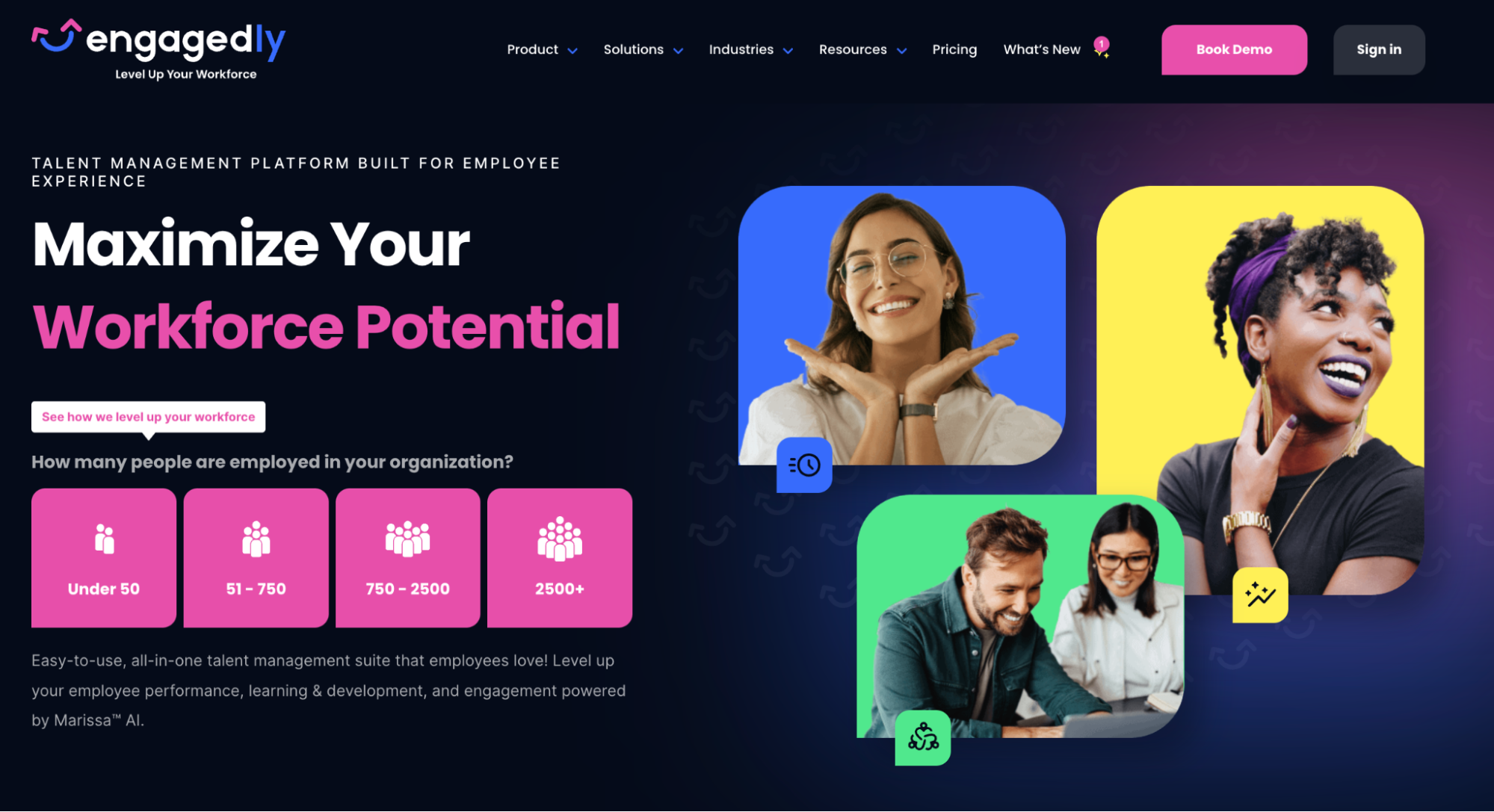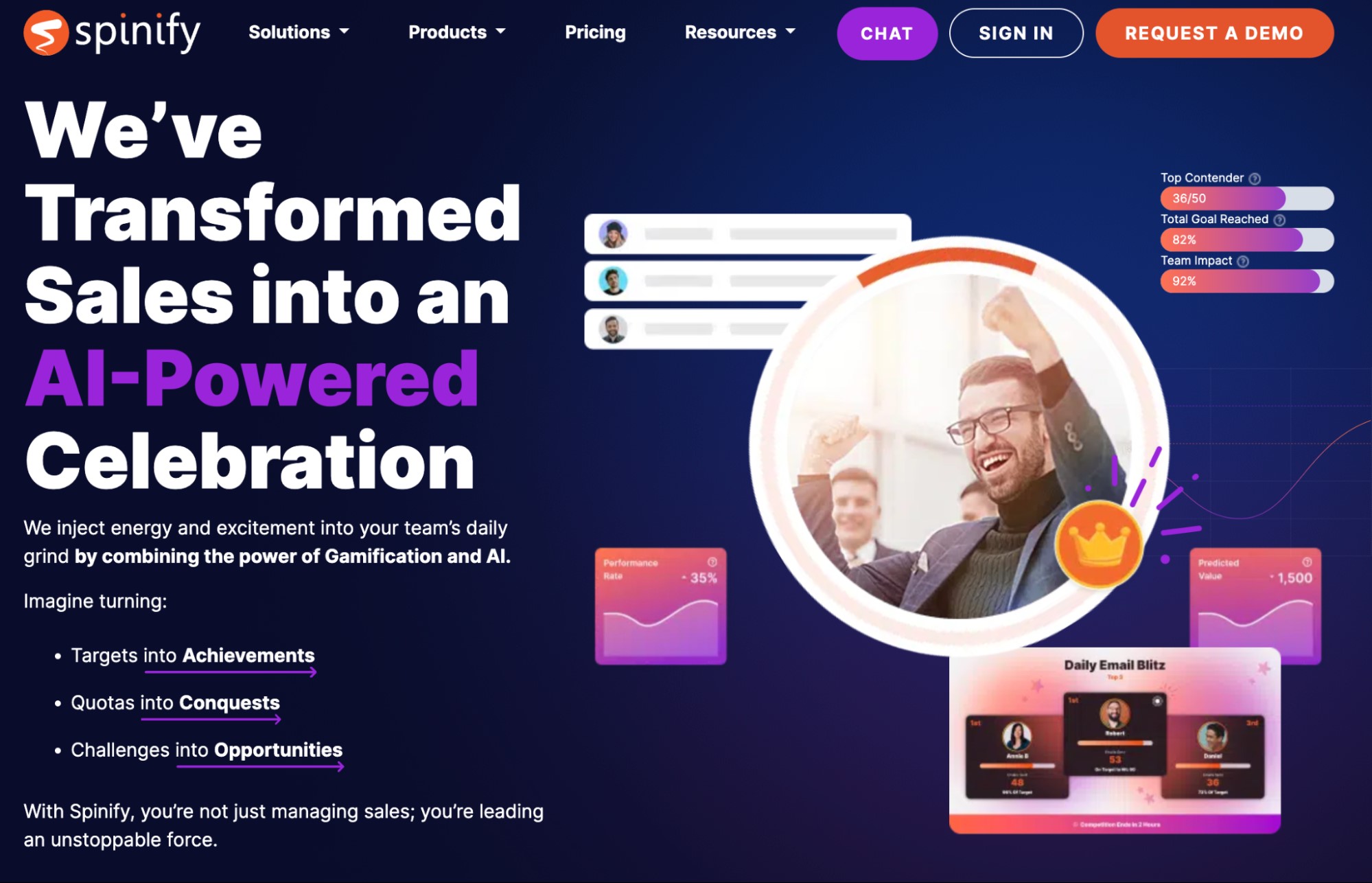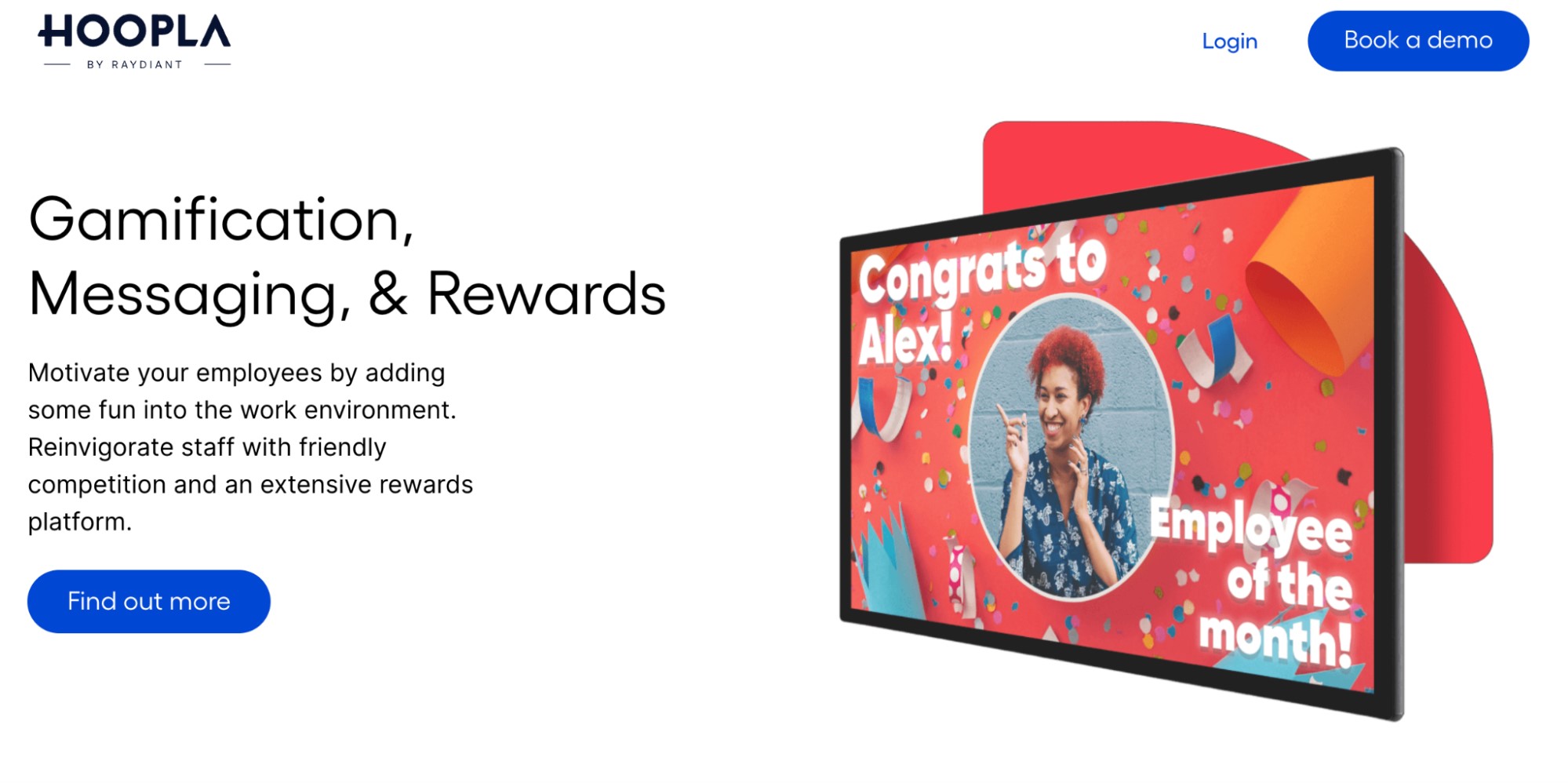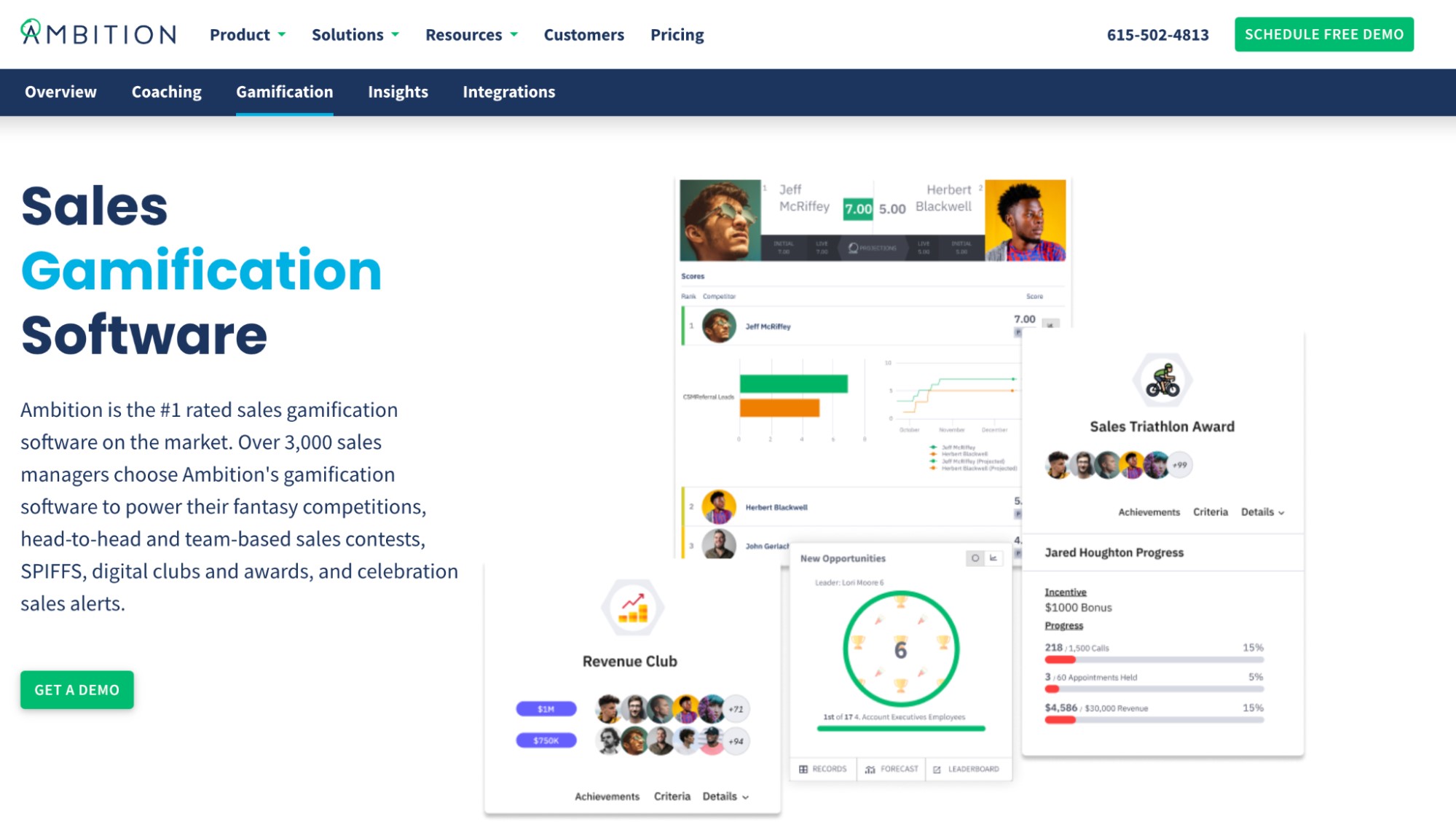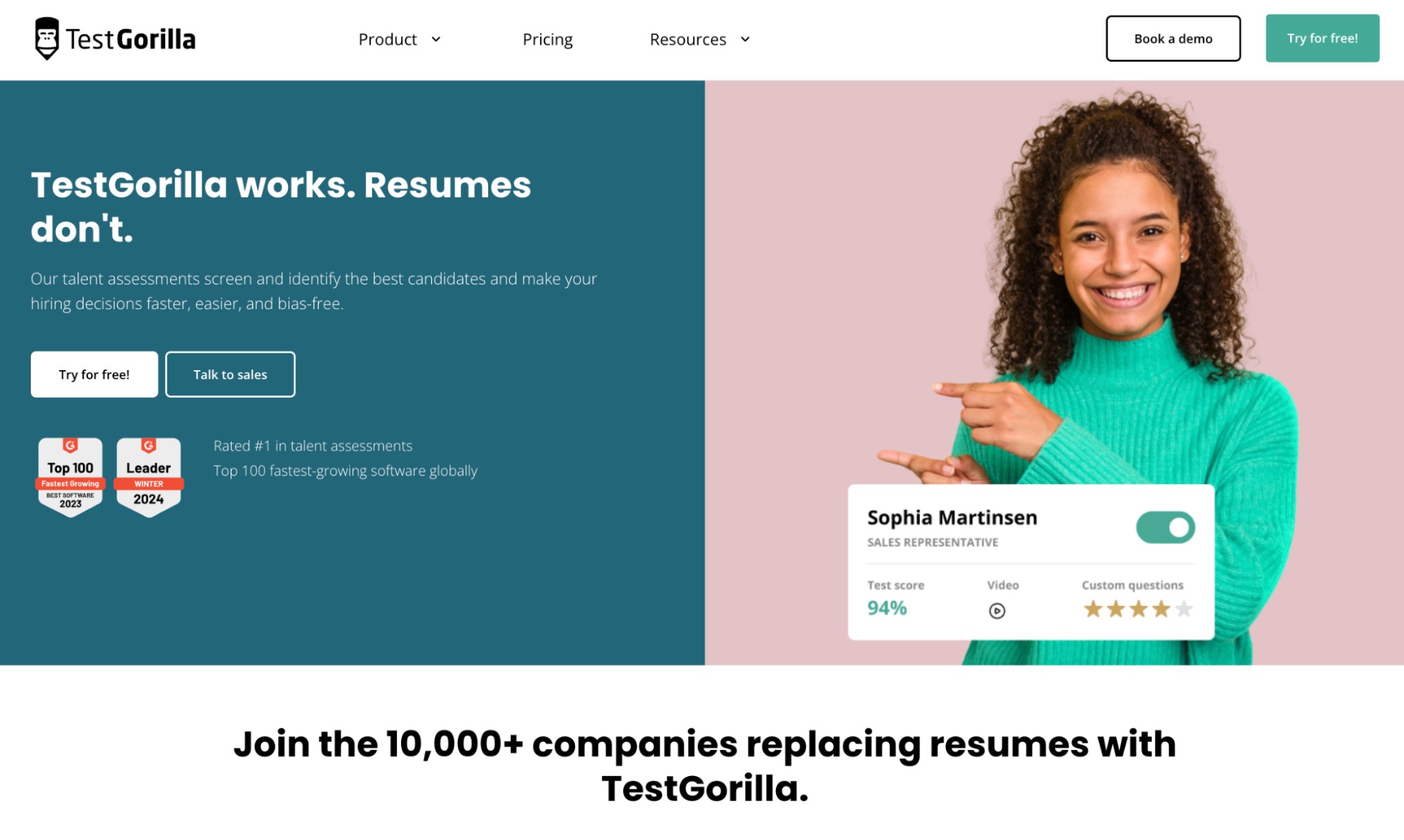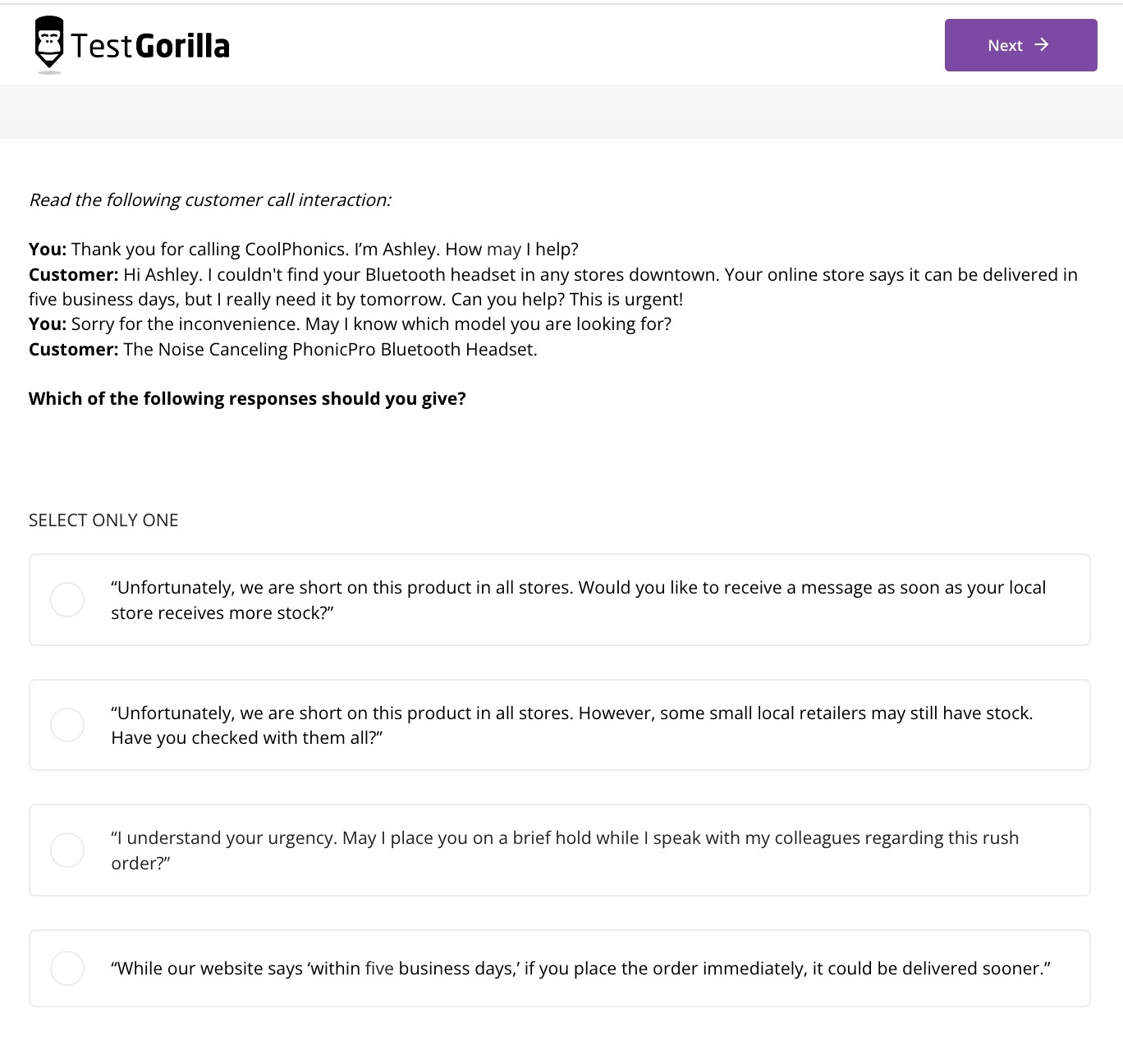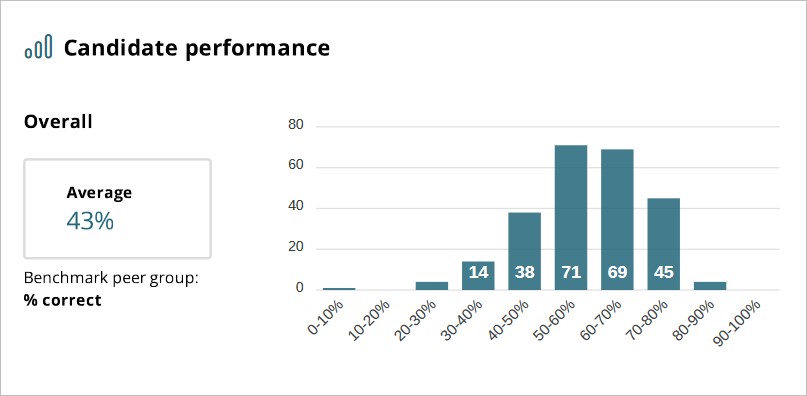Gamification in HR: A guide for HR professionals who want to make work more engaging
Employee engagement in the US is low and continues to be on the decline. The percentage of actively engaged workers across the country has dropped from 36% to 32% in recent years. [1]
The reason? People feel disconnected from their companies. They don’t:
Have access to exciting opportunities
Feel like their careers are going anywhere
Get the chance to sharpen their skills
Previously motivated employees feel lost, unrecognized, and ready to leave their companies.
For every worker you lose to poor engagement, you lose an average of $6,000 in costs to hire a new employee. [2]
It’s time to help your employees feel more connected to their work. Conceptually, the solution is simple: Take inspiration from game mechanics that make video games so engaging and apply them in non-game contexts.
Incorporating game-like elements into your company culture is known as a gamification strategy.
HR gamification is part of a broader HR technology trend that boosts productivity and engagement, makes training more effective, and helps recruits feel more welcome and connected.
Below, we show you why gamification techniques are worth investing in, where to start, and how to use technology to your advantage.
Table of contents
- What is gamification in HR?
- Why is gamification in human resources important to HR professionals?
- The benefits of HR gamification software
- 5 best HR gamification software
- 5 best practices for leveraging HR gamification in human resource management
- 3 examples of companies succeeding with gamified HR platforms
- Make work more exciting with gamification in HR
- Gamification in HR FAQs
What is gamification in HR?
Gamification in HR is about making onboarding, training, upskilling, reskilling, and work projects more engaging.
You’re encouraging workers to perform at their best, using HR technology to add game design elements to mundane concepts.
That could mean adding digital rewards such as achievements or high scores to employee training modules. Many companies gamify skill assessments by creating puzzles and simulations, too.
Gamification creates more immersive work experiences and gives employees extra rewards to work toward – not just salaries and bonuses. Simply having a trackable reward, regardless of whether it’s tangible or digital, creates intrinsic motivation for people with the potential to earn it.
Let’s explore a few examples of gamification in HR that could be fun ways to improve your own processes:
Recruitment
Competitive puzzles and quizzes
Onboarding
Competitions and leaderboards
Workplace culture quizzes
Team building initiatives among new hires
Training
Digital rewards, e.g., virtual trophies, certifications, or currency
Microlearning games
Compliance
Bonus incentives and employee recognition
Reframing personal goals as digitally tracked “quests”
Achievements and trophies, e.g., for ensuring all expenses are fully costed
Team collaboration
Team-based metrics as competition
Specific rewards for team players and top performers
Online teamwork games
Why is gamification in human resources important to HR professionals?
Around 89% of people quitting jobs do so because they feel unsupported and burnt out. Similarly, 83% feel they are going nowhere in their companies, and 22% of quitters actively look for professional growth opportunities.
They don’t want to trudge through uninspiring and exhausting projects that have no career rewards in sight.
Gamification can address this feeling of disconnection by making learning and development more fun and delivering trackable rewards.
That means people enjoy practicing their skills and get to measure progress along the way.
This process starts via recruiting technology and continues through employee onboarding. At this stage, it's a fun and easy way to help joiners acclimate to the company and socialize with others.
However, gamification is more than just sewing online games and puzzles into projects and training modules.
Businesses using this model show workers that their culture revolves around continuous development, something around 92% of job applicants are looking for.
What’s more, it boosts your employer branding because it helps show talented people that you're willing to support them and invest in their skills while also making sure they’re having fun.
Gamification software helps HR teams keep recruitment and people management efficient, productive, and supportive. These are all assets in talent acquisition, retention, and internal development.
The best insights on HR and recruitment, delivered to your inbox.
Biweekly updates. No spam. Unsubscribe any time.
The benefits of HR gamification software
To start gamifying your workplace, you need to add specialized software to your HR tech stack. We go over the five best tools available in the next section.
For now, let's consider the benefits of using HR gamification software. When used effectively, gamification tools:
Increase engagement
Boost productivity
Improve training effectiveness
Enhance hiring and onboarding
Let’s break this down.
1. Increase engagement
Research suggests that gamifying work helps to increase a healthy sense of competition. Around 89% of people taking part in gamified work feel eager to complete it, and 83% report feeling more motivated during gamified training.
Gamification taps into the deeper psychology of goal-setting. That’s because tracking progress through games helps people measure their performance and validate their sense of self-worth and achievement.
For many people, competition is a route toward achieving status and recognition.
Using software to gamify work or training gives people something extra and exciting to aim for. They could, for instance, track their "personal bests" and add digital rewards and achievements to a list of accolades.
A game-like achievement is a "dopamine hit” and just one of the languages of appreciation in the workplace.
Returning to psychology, people feel more engaged when playing games to reap extra rewards because they don't just see a paycheck. They receive small but effective checkpoints of recognition that assure them they're doing a good job.
Finally, HR gamification taps into an innate human need to be creative and to compete with others, thus driving engagement.
2. Boost productivity
Engagement helps people become more productive, but it’s not always a given. Gamification software helps you create experiences that are measurable, easy to follow, and meaningful in line with your business’s needs.
You can boost productivity from this engagement by linking games, puzzles, and achievements to specific tasks and learning outcomes. You can add incentives to task milestones and promise progression rewards.
Amazon, for example, encourages warehouse teams to hit milestones with arcade game-style tasks that reward them with digital currency, tradeable for work perks. [3]
Research supports this strategy. One survey of up to 90% of employees found they feel more productive during gamified projects. Meanwhile, 72% of the same pool believe they work harder and are more motivated with game-style tasks. [4]
3. Improves training effectiveness
Around 48% of employed people feel their training is ineffective. Thankfully, gamification helps people develop new skills more effectively and feel more confident. [5]
Studies into gamification in education find that challenge-based, gamified learning boosts performance by up to 89.5% compared with lecture-based learning.
Beyond this, gamified learning can help boost knowledge retention by up to 50%, and associated test scoring improves by up to 40%. [6]
4. Enhances hiring and onboarding
Gamification software makes both the hiring process and onboarding process more appealing, helping new hires feel better connected to the company.
As an example, you could create a badge or achievement system to help successful recruits measure their progress when joining a company.
They could have progress bars showing how far they're away from completing learning modules and digital trophies to celebrate meeting their colleagues, participating in their first projects, and completing their first months on the job.
This way, recruits feel more accomplished and confident growing in a new work environment.
It's a good opportunity to use gamified skills tests, so applicants challenge themselves. The bonus here is HR gets useful data to support candidate selection, cross-promotion, and training opportunities.
Beyond this, gamification through onboarding software helps to boost positive employer branding. Around 78% of people feel gamified recruitment would increase a company’s desirability. [7]
5 best HR gamification software
Now that we’ve explored some HR gamification examples and shown you why it’s worth investing in, let’s explore the best tools to add to your tech stack.
During our research, we found five leading recruiting platforms and HR tools with gamification features worth your investment.
Factors we considered
We prioritized the following factors when researching gamification software for HR:
Cost and pricing tiers
Ease of use
Integrations with other software
Specific features (e.g., achievements, badges, and points systems)
Customization
Remember, you’re likely to have specific needs to prioritize alongside these factors, so please use this list as a starter guide.
Top HR gamification tools worth investing in
Gamification tool | Pros | Cons |
1. Engagedly | - Lots of customization available - Easy for users and managers to track goals | - Manual updates can be tedious - There is a slight learning curve for new users |
2. Spinify | - Takes lots of creative strain out of designing gamified elements - AI analyzes your data to create measured goals and achievements | - Might be costly for some operations - The learning curve could be gentler |
3. Hoopla | - Helps you celebrate employee achievements with exciting visuals - Custom currency and rewards systems are available | - Some users find CRM integration a little complex |
4. Ambition | - Highly customizable contests and leaderboards for sales teams - Operates within its own performance tracker and predictive analytics system | - Some users experience connectivity delays - Other tools engage with employees more directly |
5. TestGorilla | - Hundreds of talent assessment templates to support training and hiring for skills - Custom questions and video content support a more engaging workplace experience | - Requires effort and creative thinking to gamify |
1. Engagedly: Best for goal tracking
Engagedly is a popular talent management suite with a gamification tool that offers customizable goal tracking, achievements, and leaderboards.
Its customizable performance management system enables HR to design point systems around work tasks and training modules. It's popular with employees and HR users for its ease of tracking.
The tool offers a gift card incentive system, meaning you can tailor legitimate rewards to an achievement program you design from scratch.
Rating: 4.4 stars out of five (G2, 528 reviews)
Pricing at time of writing: Base packages start from $5,000
2. Spinify: Best for creative gamification ideas
Much like Engagedly, Spinify offers a range of customizable leaderboards and achievement tools to design a gamified workplace.
Its creative tool, Sidekick, supports the use of AI in HR by suggesting award names and designs and helping to measure achievements and milestones. Working from your data, it creates custom badges and writes messages to help boost employee engagement.
The software is easy to integrate with existing spreadsheets and databases, working alongside third-party tools such as HRIS systems and Hubspot, Zapier, Pipedrive, and Salesforce CRMs.
Rating: 4.6 stars out of five (G2, 608 reviews)
Pricing at time of writing: From $70 per month for five seats (scalable)
3. Hoopla by Raydiant: Best for employee recognition
Hoopla, part of the Raydiant family, lets you create plug-and-play challenges and leaderboards that tie in seamlessly with performance tracking.
This employee recognition software stands out from other HR gamification tools thanks to its “shoutout” recognition features, helping you tie competition data to empowering messages and celebrations.
You can also enable users to check and track leaderboard progress on displays and shared networks.
The suite uses a point-based currency system, meaning top performers can cash in their achievements for real rewards.
Rating: 4.5 stars out of five (G2, 666 reviews)
Pricing at time of writing: Pricing available on request
4. Ambition: Best for sales teams
Ambition is a performance management service tailored to sales teams. Its main selling point to managers is that it tracks past performance and forecasts employee performance for the future. Alongside this, it offers a customizable gamification platform.
Users can create custom contests and leaderboards driven by real-time sales data that everyone can track from HR dashboards and public screens. There's functionality for "Accolades," too, that managers can design around specific sales goals whenever they wish.
Individual reps can give each other Accolades as thank-yous, boosting teamwork and peer-to-peer recognition.
Rating: 4.6 stars out of five (G2, 571 reviews)
Pricing at time of writing: Pricing available on request
5. TestGorilla: Best for gamified talent assessments
TestGorilla helps you measure genuine skills while making hiring and training fun and trackable.
Alongside its candidate assessment software, you can create custom training questionnaires based on hundreds of professional job profiles.
Then, you can gamify these custom quizzes with other software to encourage people to find new training opportunities. Why not offer badges and digital rewards for scoring more than 90% on a skills test?
Beyond testing, the software supports video responses to help people engage more personally with the process. On HR's side, it's easy to track, rank, and manage scores when deciding who to hire, cross-promote, and upskill.
Although TestGorilla doesn’t directly have game elements built-in, it gives you enough in-depth and easy-to-read data to creatively incorporate into your gamification strategy.
Rating: 4.5 stars out of five (G2, 1,020 reviews)
Pricing at time of writing: Available for free, Lite package starts at $499 per month for any size company
5 best practices for leveraging HR gamification in human resource management
If you’re feeling inspired to start gamifying recruitment and training, here are five ideas to help you on your way.
Gamification in human resources: Tips for getting started
Best practice | Brief summary |
1. Carefully choose processes to gamify | Research where people need more engagement and set achievable goals before investing in software |
2. Match gamified functions to your objectives | Set highly specific gamification goals tied to the outcomes you want, or risk missing objectives and losing productivity |
3. Move to skills-based practices | Reward people who take talent assessments to help them feel appreciated, confident, and motivated to grow their talent with you |
4. Gamify training and development | Help people track training progress with gamified elements, so they have real-time feedback and are confident about what to do next |
5. Get feedback from employees and keep improving | Ask your workforce how to motivate them better with gamification and appeal to different learning styles, career needs, and motivation drivers |
1. Carefully choose processes to gamify
Think carefully about where you could benefit from gamification the most in your HR processes. What types of behavior do you want to motivate, for example?
Let’s say you notice, through HR analytics, that applicants are dropping out of the recruitment process at one or two stages. You could introduce skills tests or games to replace mundane questionnaires and then measure aptitude.
This strategy helps to keep applicants engaged and interested in following through to interviews. At the same time, you benefit from reliable, objective skills data to measure and compare recruits.
It’s not necessary to gamify everything because doing so might mentally exhaust your employees or make your workplace over-competitive.
Instead, prioritize known pain points in your business where people seem disengaged or feel poorly supported. For instance, pay attention to employee pulse surveys and ask your teams what they feel could help make work more engaging and enjoyable.
In return, make goals clear and achievable. For recruitment and onboarding, you could even set the bar slightly lower than you might typically. People who feel a challenge is impossible only get more frustrated.
Use your teams' feedback to develop leaderboards, point systems, and rewards that people genuinely want to achieve.
2. Match gamified functions to your objectives
Games should have goals that tie closely to your objectives. Let's say, as an example, the bulk of your coding projects are Python-based.
In this case, it makes little sense to gamify training in as many languages as possible when you ideally need to focus on developing Python expertise. Your team is engaged but missing objectives by working too broadly.
Moreover, as much as work should be fun, there are still deadlines to meet.
Consider all your business goals, no matter how narrow or broad. Say you want to improve customer care standards – in this case, you could use games and tests tied to customer service skills:
Alternatively, you might want to make learning and development more engaging and accessible for people to track.
Therefore, consider matching trophies and achievements to checkpoints as employees progress through modules. You could offer digital currency as a reward for achieving certain scores.
Make sure to refresh your gamified functions regularly as your business objectives change. Show people what you expect from them when playing games to achieve goals – use a system that gives instant feedback so that people know where they stand.
A good example might be progress bars, as mentioned earlier. Percentage tracking helps you and your teams visualize where they stand in real time.
3. Move to skills-based practices
Many gamification practices fit well with skills-based assessments and development. For instance, skills tests and recruitment games both revolve around innate talent rather than experience.
Moving toward a skills-based workforce and recruitment model holds lots of benefits. Our research proves it – The State of Skills-Based Hiring 2024 found that 90% of companies that adopt skills-based recruitment reduced mis-hiring, and 91% boosted employee retention.
Gamifying with skills in mind helps people understand their strengths and weaknesses more clearly.
What’s more, these strengths and weaknesses are clearer to HR with skill test results, which aids with internal recruitment and lateral moves across a business.
Through gamification, you make it easy for people to track their upskilling progress with checkpoints and badges. This strategy makes skill development feel more tangible and helps people become more confident they can achieve their goals.
Start to hire for skills and insert tests into individual development plans to assess for gaps and strengths in your workforce. This data could inform your future hiring drives and role descriptions.
From HR’s side, it’s easy to track skills progress and to identify where to prioritize support. Here’s an example of an overall candidate performance spread available through TestGorilla:
4. Gamify training and development
Up to 70% of employees in the US feel “somewhat” empowered to leave one job for another if they’re known for learning and development opportunities. Therefore, it pays to make development as engaging as possible so you become the company people leave others for.
As mentioned above, gamifying learning and development helps employees track their progress and empowers them to proceed. So, using gamification software encourages workers to keep striving for new goals and gives them clear feedback so they’re always on the right track.
Look carefully at your current training and development processes and the results they produce. If you struggle to upskill employees enough to satisfy roles and responsibilities, it might be time to change how you train them, not your module contents.
Setting up leaderboards could make training and development competitive. You could make learning module scoring public, encouraging healthy competition as your employees strive to become the most highly skilled.
5. Get feedback from employees and keep improving
Always ask employees for feedback regarding your gamification techniques. It’s easy to assume that generic puzzles and trophies are enough to inspire everyone.
Yet we all learn and develop differently; not everyone responds similarly to games and incentives. Therefore, create open-ended questionnaires and ask for suggestions as to how to keep making work and development more engaging.
You could ask your teams what inspires them when working on projects. Is there a need for more autonomy? Could you balance more employee self-service with gamified elements, for instance?
Never assume that your first gamified system is one and done. As mentioned earlier, you must regularly update your goals and games as your business changes.
Monitor recruits through applicant tracking systems while you roll out games. Are they helping to reduce applicant ghosting or time-to-hire? If not, keep testing and analyzing results.
3 examples of companies succeeding with gamified HR platforms
For some final inspiration, the following three companies have some great gamification stories to tell:
Experian
Chowly
emedia
Let’s break down how gamification has improved their people management.
1. Experian
Experian, the personal credit management brand, used Engagedly to help simplify and strengthen its performance reviews.
Struggling to manage complex documents and track employee performance, the company continuously "reinvented" its system every year. This issue resulted in confusion, lost time, and poor employee engagement.
The company turned things around by gamifying progress tracking through badges, which personnel give to each other digitally as thanks for support on projects and in recognition of hard work.
These features helped the firm boost its employee engagement by 10% and reduced time and effort spent on performance reviews by up to 75%. [8]
2. Westkey Graphics
Westkey Graphics, a Canadian manufacturing firm, uses Spinify to help boost team productivity and give out creative badges and awards to employees.
Working without a major CRM, the company adopted the gamification service to program and manage Google Sheets. This strategy has helped the firm easily track activity outcomes in real time.
Seeing teams produce work up to 1200x more than quotas set, the company mentions that the creative badge and award customization add a genuine sense of fun to the working day. The ease of outcome tracking, too, has made moving to gamification smoother. [9]
3. emedia
emedia, a leading name in B2B lead generation, initially gamified everyday tasks such as sales calls and prospect meetings through Salesforce's CRM. However, the company found it difficult to track progress, and there was little room to scale.
Finding it spent ample time tweaking and fixing the software; the firm instead moved toward Hoopla, which is available as an app for the CRM.
Using the app, the company began assigning custom point values for different tasks, publicly recognizing top performers, and setting up action events that trigger when people reach goals.
The business boosted activity reporting by 60% and even noted a 25% increase in sales revenue month-over-month. [10]
Make work more exciting with gamification in HR
In the recent era, companies have struggled to keep their employees engaged and excited. Statistics back this up, showing there’s quite a ways to go before American firms turn disengagement around.
Gamification in HR and recruitment offers fun, exciting ways to help people engage more with their work, personal goals, and companies. In return, HR departments can expect:
More positive employer branding
Fewer job applicants ghosting mid-process
Greater employee motivation
Faster and more effective knowledge retention
Remember to tie goals and objectives to any elements you gamify. That way, you keep your teams engaged and productive.
From here, we recommend learning more about employee experience software and measuring how your teams feel about gamification.
Then, if you’re keen to learn more about how cutting-edge technology supports a happier, more productive workforce, dive into our guide to AI in HR.
Want a closer look at hundreds of talent assessments to start your gamification process today?
Try the TestGorilla demo, or take control and sign up for a free account!
Gamification in HR FAQs
Let’s close with some common queries about HR gamification.
What is recruitment gamification?
Recruitment gamification adds game or challenge elements to job application and interview processes.
For example, an HR manager might give computer programmers coding puzzles before setting up an interview.
Such puzzles let applicants show off their programming skills and have fun. It's engaging for them and gives HR useful data to compare.
What is an example of gamification in the workplace?
An example of work gamification might be a “levels” system, where employees train and develop specific skills, earning badges and “leveling up” along the way.
They might be able to show off these badges and accolades in their work profile, proud of their achievements.
Alternatively, some learning or work tasks might give digital currency that workers can use toward company perks such as extra paid time off or branded apparel.
Why use gamification in the workplace?
Gamification in the workplace helps people feel more engaged and connected with their colleagues and companies.
The future of HR technology revolves around ensuring people feel valued and are given chances to excel. With elements of challenge added to their development and projects, employees feel more compelled to complete them and enjoy rewards.
In turn, gamification helps to boost productivity and helps new hires and employees feel more connected to their teams.
What is the future of gamification in HR and recruitment?
Gamification and HR is still a relatively young pairing, but it's already helping household brands empower their employees. As companies continue to drive positive engagement by gamifying work, the trend will likely grow more popular toward the end of the decade.
Top gamification software providers such as Spinify already use artificial intelligence, or AI, to create employee rewards and goals at the click of a mouse.
Sources
1. Harter, Jim. (January 25, 2023). "US Employee Engagement Needs a Rebound in 2023". Gallup Workplace. Retrieved January 22, 2024. https://www.gallup.com/workplace/468233/employee-engagement-needs-rebound-2023.aspx
2. Navarra, Katie. (April 11, 2022). “The Real Costs of Recruitment”. SHRM. Retrieved January 22, 2024. https://www.shrm.org/topics-tools/news/talent-acquisition/real-costs-recruitment
3. Statt, Nick. (March 15, 2021). “Amazon expands gamification program that encourages warehouse employees to work harder”. The Verge. Retrieved January 22, 2024. https://www.theverge.com/2021/3/15/22331502/amazon-warehouse-gamification-program-expand-fc-games
4. Boskamp, Elsie. (February 23, 2023). “25 Gamification Statistics [2023]: Facts + Trends You Need To Know”. Zippia. Retrieved January 22, 2024. Retrieved January 22, 2024. https://www.zippia.com/advice/gamification-statistics/
5. “Axonify Finds No Improvement in Corporate Training in Second Annual State of Workplace Training Study”. (February 20, 2018). Axonify. Retrieved January 22, 2024. https://axonify.com/en-uk/news/axonify-finds-no-improvement-corporate-training-second-annual-state-workplace-training-study/
6. Krause, Markus, et al. (March 2015). “A Playful Game Changer: Fostering Student Retention in Online Education with Social Gamification”. L@S '15: Proceedings of the Second (2015) ACM Conference on Learning @ Scale, Pages 95–102, and ACM Digital Library. Retrieved January 22, 2024. https://dl.acm.org/doi/abs/10.1145/2724660.2724665
7. Apostolopoulos, Aris. (August 19, 2019). “The 2019 Gamification at Work Survey”. TalentLMS. Retrieved January 22, 2024. https://www.talentlms.com/blog/gamification-survey-results/
8. “Employee Engagement Increases by 10%: Experian”. Engagedly. Retrieved January 22, 2024. https://engagedly.com/case-study/experian/
9. “Westkey Graphics have increased Activities and Outcomes using Spinify!”. Spinify Customer Stories. Retrieved January 24, 2024. https://spinify.com/customer-story/westkey-graphics-have-increased-activities-and-outcomes-using-spinify/
10. “Hoopla: emedia”. Hoopla. Retrieved January 24, 2024. https://cdn.featuredcustomers.com/CustomerCaseStudy.document/hoopla_emedia_36694.pdf
You've scrolled this far
Why not try TestGorilla for free, and see what happens when you put skills first.


